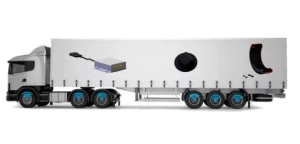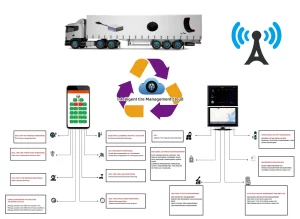In today’s fast-paced world of fleet management, optimizing every aspect of vehicle performance is crucial for reducing costs, enhancing safety, and improving operational efficiency. One of the most overlooked yet vital components of any fleet operation is tire management. The introduction of the PC Intelligent Tire Management Platform is transforming how businesses approach tire maintenance, offering an innovative solution to a critical issue.
In this article, we will explore the benefits, features, and real-world applications of PC-based tire management systems, and how they can help fleet managers improve tire health, reduce costs, and enhance overall fleet performance.

What Is a PC-Based Tire Management Platform?
A PC Intelligent Tire Management Platform is an advanced software solution designed to monitor, manage, and optimize the health of vehicle tires in real-time. Unlike traditional methods, which rely on manual inspections and basic maintenance schedules, these platforms use data from tire sensors, telematics, and advanced analytics to provide detailed insights into tire condition, pressure, temperature, and wear patterns.
The system integrates with your fleet’s overall management platform, allowing fleet managers to remotely monitor tire health, receive predictive maintenance alerts, and make informed decisions about tire replacement and repairs. With real-time data and AI-driven insights, this platform helps minimize tire-related breakdowns, reduce fuel consumption, and extend the lifespan of tires.
Key Benefits of Using a PC-Based Tire Management Platform
1. Enhanced Fleet Efficiency
One of the primary advantages of a PC Intelligent Tire Management Platform is the ability to enhance fleet efficiency. By continuously monitoring tire conditions, fleet managers can prevent downtime caused by tire failure, which can be costly and disruptive. Sensors embedded in the tires track parameters like pressure, temperature, and tread wear, alerting managers to any anomalies that could lead to issues.
By identifying problems early, such as underinflation or tire misalignment, fleet managers can ensure that vehicles are operating at peak efficiency. This reduces costly repairs, minimizes delays, and improves on-time delivery in logistics and transportation fleets.
2. Cost Savings: Lower Tire and Fuel Costs
Tire-related expenses, including replacement, maintenance, and fuel consumption, can be a significant cost burden for fleets. With a PC Intelligent Tire Management Platform, these costs can be reduced significantly. Proper tire inflation, automatically monitored by the platform, plays a crucial role in optimizing fuel efficiency. Underinflated tires increase rolling resistance, leading to higher fuel consumption.
By maintaining optimal tire pressure, the system helps reduce fuel costs. Additionally, predictive maintenance allows fleet managers to identify when tires are nearing the end of their useful life or need repairs, preventing premature tire replacements and extending the lifespan of tires.
3. Improved Fleet Safety
Tire failures are one of the leading causes of accidents in fleet operations. A PC Intelligent Tire Management Platform helps improve fleet safety by providing early warnings about potential tire issues, such as blowouts, tread wear, or overheating. These alerts enable fleet managers to take proactive measures, preventing hazardous situations and ensuring the safety of both drivers and cargo.
The platform’s real-time monitoring ensures that tires are always in optimal condition, reducing the likelihood of unexpected tire failures on the road.
4. Predictive Maintenance: Plan for Tires Before They Fail
With the integration of artificial intelligence (AI) and machine learning (ML), PC Intelligent Tire Management Platforms offer predictive maintenance features. These systems use historical data, tire performance trends, and environmental factors to predict when a tire is likely to fail or require attention.
This predictive capability enables fleet managers to plan maintenance proactively, reducing unexpected breakdowns and minimizing tire-related disruptions. By addressing issues before they become critical, fleet managers can avoid costly repairs, ensure vehicle uptime, and streamline fleet operations.
Core Features of a PC-Based Tire Management Platform
1. Real-Time Tire Monitoring
Real-time tire monitoring is the cornerstone of any PC Intelligent Tire Management Platform. The system uses sensors embedded in the tires to collect data on pressure, temperature, tread depth, and wear patterns. This data is continuously transmitted to the platform, providing fleet managers with a live overview of tire health across the entire fleet.
With this feature, fleet managers can quickly identify issues such as underinflation, overheating, or abnormal wear and take corrective action before a tire failure occurs.
2. Advanced Data Analytics and Insights
A powerful data analytics engine processes the tire data, transforming raw information into actionable insights. Dashboards and reports provide fleet managers with an overview of tire health, highlighting trends, potential issues, and areas for improvement.
Advanced data analytics allow managers to make data-driven decisions regarding tire replacement cycles, maintenance schedules, and overall tire performance optimization, ensuring the fleet runs smoothly.
3. Instant Alerts and Notifications
The PC Intelligent Tire Management Platform sends instant alerts and notifications to fleet managers when tire conditions deviate from optimal performance. These alerts could include warnings about low tire pressure, excessive temperature, or abnormal wear, allowing fleet managers to address issues before they result in significant problems.
Alerts are customizable and can be sent via email, SMS, or app notifications, ensuring that fleet managers are always informed, no matter where they are.
4. Seamless Integration with Fleet Management Systems
A PC-based tire management platform can be easily integrated with other fleet management software, such as GPS tracking, maintenance management, and fuel monitoring platforms. This integration provides a unified view of fleet operations, enabling fleet managers to make holistic decisions based on comprehensive data.
How the PC Tire Management Platform Benefits Different Industries
1. Logistics and E-Commerce Fleets
For logistics and e-commerce fleets, tire maintenance is critical for ensuring timely deliveries and reducing operational disruptions. By using a PC Intelligent Tire Management Platform, logistics companies can prevent tire-related delays, optimize fuel efficiency, and reduce overall maintenance costs. Real-time monitoring and predictive maintenance can help improve service delivery and reduce the risk of costly tire failures.
2. Public Transportation
In the public transportation sector, safety and reliability are top priorities. The PC Intelligent Tire Management Platform helps monitor the condition of tires on buses, trains, and other vehicles, preventing accidents caused by tire failures. By ensuring that tires are in optimal condition, public transportation agencies can reduce service interruptions and enhance safety for passengers and drivers alike.
3. Construction and Heavy Equipment Fleets
Construction and heavy equipment fleets rely on vehicles that operate in harsh conditions. Tires on construction vehicles face extreme loads and wear, leading to a need for more frequent monitoring. A PC Intelligent Tire Management Platform provides real-time data to help construction companies monitor tire health, schedule maintenance, and ensure that vehicles remain operational and safe.

A PC Intelligent Tire Management Platform is a game-changer for fleet managers, offering a sophisticated, data-driven solution to optimize tire health, reduce costs, and enhance fleet safety. With real-time monitoring, predictive maintenance, and seamless integration with fleet management systems, businesses can ensure their tires are always in top condition, preventing downtime, improving fuel efficiency, and lowering maintenance costs.
By adopting a PC-based tire management platform, companies can stay ahead of the curve, transforming their fleet management practices and paving the way for a safer, more cost-effective future.

